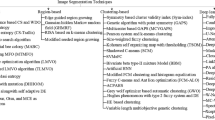Abstract
Semantic segmentation has several applications in remote sensing, including but not limited to land use classification, change detection, and environmental monitoring. The main challenge in accepting the segmentation algorithms is that there are no labeled data over different terrains and geographies. Pixel-level labeling calls for particular knowledge and experience due to the possibility that each pixel in a satellite image could represent a sizable portion of the globe. Using CNN, U-Net, Res2-Unet, and other machine learning models, we examined earlier research in this study, which included semantic segmentation of satellite pictures. In this study, the literature is assessed using experimental dataset and evaluation metrics like as precision, recall, f1-score, IoU, and mIoU. Also, common issues with semantic segmentation of satellite images were investigated. We also looked into potential future research in this field.
Access this chapter
Tax calculation will be finalised at checkout
Purchases are for personal use only
Similar content being viewed by others
References
Wu F, Peng X, Xu J (2014) LineCast: Line-based distributed coding and transmission for broadcasting satellite images. IEEE Trans Image Process 23:1015–1027. https://doi.org/10.1109/TIP.2014.2298972
Dong X, Quegan S, Yumiko U, Hu C, Zeng T (2015) Feasibility study of C- and L- band SAR time series data in tracking Indonesian plantation and natural forest cover changes. IEEE J Sel Top Appl Earth Obs Remote Sens 8:3692–3699. https://doi.org/10.1109/JSTARS.2015.2400439
Zeeshan S (2018) Karachi using GPS And GIS : a case study. In: 7th International conference on computer and communication engineering technology. pp 1–4
Ahmed SM, Muhammad H, Sivertun Å (2006) Solid waste management planning using GIS and remote sensing technologies case study Aurangabad City, India. Int Conf Adv Sp Technol ICAST.196–200. https://doi.org/10.1109/ICAST.2006.313826
Terekhov A, Muratova N (2002) Agriculture land use recognition by multi-temporary middle resolution satellite data in Northern Kazakhstan. Int Geosci Remote Sens Symp 5:2787–2789. https://doi.org/10.1109/igarss.2002.1026775
Alp G, Algan IY, Sertel E (2015) Determination of agricultural land changes in Mugla, Turkey using remotely sensed data and Corine methodology. In: 4th International conference on agro-geoinformatics pp 7–10. https://doi.org/10.1109/Agro-Geoinformatics.2015.7248083.
Chantharaj S, Pornratthanapong K (2018) Semantic segmentation on medium-resolution satellite images using deep convolutional networks with remote sensing derived indices. 15th Int J Comput Sci Softw Eng 1–6
Garcia-Garcia A, Orts-Escolano S, Oprea S, Villena-Martinez V, Garcia- Rodriguez J (2017) A review on deep learning techniques applied to semantic segmentation 1–23
Arbel P, Berkeley B, Rd W, Park M (2012) Semantic segmentation using regions and parts 3378–3385
Long J, Shelhamer E, Darrell T Fully convolutional networks for semantic segmentation 9
Bekkari A, Idbraim S, Housni K, Mammass D (2010) Classification of high resolution urban satellite images combining SVM and graph cuts 2–5
Manthira Moorthi S, Misra I, Kaur R, Darji NP, Ramakrishnan R (2011) Kernel based learning approach for satellite image classification using support vector machine. IEEE Recent Adv Intell Comput Syst RAICS 2011. 107–110. https://doi.org/10.1109/RAICS.2011.6069282
Neware R, Khan A (2018) Cloud computing digital forensic challenges. In: Proceedings of the 2nd International Conference on Electronics, Communication and Aerospace Technology ICECA2018.1090–1092. https://doi.org/10.1109/ICECA.2018.8474838
Khryashchev VV, Ostrovskaya AA, Pavlov VA, Semenov AS (2018) Optimization of convolutional neural network for object recognition on satellite images. Syst Signal Synchronization Gener Process Telecommun SYNCHROINFO. pp 1–5. https://doi.org/10.1109/SYNCHROINFO.2018.8457056
Chen F, Wang N, Yu B, Wang L (2022) Res2-Unet, a new deep architecture for building detection from high spatial resolution images. IEEE J Sel Top Appl Earth Obs Remote Sens 15:1494–1501. https://doi.org/10.1109/JSTARS.2022.3146430
Im H, Yang H (2019) Analysis and optimization of CNN-based Semantic segmentation of satellite images. In: ICTC 2019—10th International conference on ICT convergence: ICT convergence leading the autonomous future. pp 218–220. https://doi.org/10.1109/ICTC46691.2019.8939782
Rehman MFU, Aftab I, Sultani W, Ali M (2022) Using a semi-supervised approach. 19
Zhang X, Li J, Hua Z (2022) MRSE-Net: multi-scale residuals and se-attention net- work for water body segmentation from satellite images. IEEE J Sel Top Appl Earth Obs Remote Sens 15:1–17. https://doi.org/10.1109/jstars.2022.3185245
Li Z, Zhang X, Xiao P, Zheng Z (2021) On the effectiveness of weakly supervised semantic segmentation for building extraction from high-resolution remote sensing imagery. IEEE J Sel Top Appl Earth Obs RemoteSens 14:3266–3281. https://doi.org/10.1109/JSTARS.2021.3063788
Wu M, Zhang C, Liu J, Zhou L, Li X (2019) Towards accurate high resolution satellite image semantic segmentation. IEEE Access 7:55609–55619. https://doi.org/10.1109/ACCESS.2019.2913442
Nivaggioli A, Randrianarivo H (2019) Weakly supervised semantic segmentation of satellite images. 2019 Jt. Urban Remote Sens Event JURSE2019. 1–4. https://doi.org/10.1109/JURSE.2019.8809060
Bengana N, Heikkila J (2021) Improving land cover segmentation across satellites using domain adaptation. IEEE J Sel Top Appl Earth Obs RemoteSens 14:1399–1410. https://doi.org/10.1109/JSTARS.2020.3042887
Li R, Wang L, Zhang C, Duan C, Zheng S(2022) A2-FPN for semantic segmentation of fine-resolution remotely sensed images. Int J Remote Sens 43:1131–1155. https://doi.org/10.1080/01431161.2022.2030071
Hordiiuk D, Oliinyk I, Hnatushenko V, Maksymov K (2019) Semantic segmentation for ships detection from satellite imagery. In: Proceedings of IEEE 39th international conference on electronics and nanotechnology, ELNANO. pp 454–457. https://doi.org/10.1109/ELNANO.2019.8783822
De Oliveira JP, Costa MGF, Costa Filho CFF (2020) Methodology of data fusion using deep learning for semantic segmentation of land types in the amazon. IEEE Access 8:187864–187875. https://doi.org/10.1109/ACCESS.2020.3031533
Author information
Authors and Affiliations
Corresponding author
Editor information
Editors and Affiliations
Rights and permissions
Copyright information
© 2023 The Author(s), under exclusive license to Springer Nature Singapore Pte Ltd.
About this paper
Cite this paper
Mehta, Y., Katkar, V., Patel, S. (2023). Semantic Segmentation of Optical Satellite Images. In: Murthy, B.K., Reddy, B.V.R., Hasteer, N., Van Belle, JP. (eds) Decision Intelligence. InCITe 2023. Lecture Notes in Electrical Engineering, vol 1079. Springer, Singapore. https://doi.org/10.1007/978-981-99-5997-6_9
Download citation
DOI: https://doi.org/10.1007/978-981-99-5997-6_9
Published:
Publisher Name: Springer, Singapore
Print ISBN: 978-981-99-5996-9
Online ISBN: 978-981-99-5997-6
eBook Packages: Intelligent Technologies and RoboticsIntelligent Technologies and Robotics (R0)




